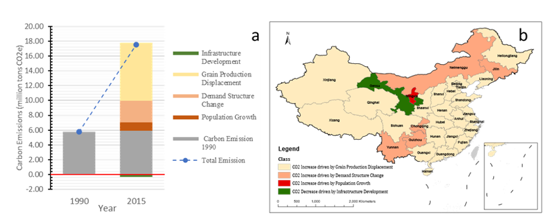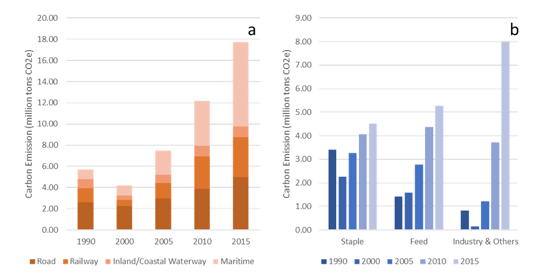
The migration of rural labour to the cities has been one of the distinctive features of China's economic and social development since the reform and opening up. The increasing size of the migrant population has led to the rapid growth of the migrant worker group as the third pole of China's residential structure. As the main labour supplier and an important consumer group in cities, migrant workers, however, show a lower willingness to stay long-term and a higher household savings rate. This paper uses data from the National Mobility Monitoring Survey to conduct an empirical study to establish a causal identification mechanism between house prices and savings rates through migrant workers' willingness to stay in cities. The study finds that rising house prices reduce migrant workers' willingness to stay in the city on a long-term basis, while a decline in willingness to stay leads to an increase in the savings rate of migrant workers' households. In particular, the savings rate of low- and middle-income households, first-generation migrant households, and migrant households that have only received compulsory education and intend to move to other cities or return home in the future are more sensitive to rising house prices. In addition, the paper finds that the positive effect of rising house prices on the savings rate of migrant workers' households is more pronounced in the western and northeastern regions. The findings of this paper provide a new perspective to explain the phenomenon of high savings of migrant workers and offer policy implications for expanding domestic demand, promoting consumption and building a new development pattern.
Carbon emissions generated by the food supply chain account for one-third of the total carbon emissions of human society, so related research has been among the hot spots of carbon emissions research. With the urbanisation of the world, the number of urban dwellers is increasing, while the arable land around the cities is constantly being encroached upon by residential and industrial and commercial land, so more and more food is produced on arable land farther and farther away from urban dwellers. Clearly, this displacement is significant and means that more food has to be transported from more distant areas of production to areas of consumption, with correspondingly greater energy consumption and carbon emissions.
The problem of arable land displacement is particularly acute in China because, in order to reconcile the need for land for urban development with the strict protection of the total amount of arable land (the red line), China has adopted a "balance of occupation and replenishment" approach to arable land, which means that the amount of arable land taken up by urban construction must be reclaimed in the same quantity and quality to keep the total amount constant. As you can imagine, new arable land will only be reclaimed further away from the cities, and after 2018, the changed approach to arable land protection will further allow for a balance of arable land between different provinces. This is certainly conducive to the co-ordinated and optimal allocation of land resources across the country and the strict adherence to the red line of 1.8 billion mu of arable land. But on the other hand, it will also make the problem of arable land displacement, and even the corresponding increase in carbon emissions from food transportation, more prominent.
A recent paper published in Nature Food, a collaboration between our group, the College of Geography at the University of Leeds, the Macro Agricultural Research Institute at Huazhong Agricultural University and the International Food Policy Research Institute in Washington, D.C., uses spatial interaction models, cereal production and consumption data and transport road network data to measure carbon emissions from cereal transport in China between 1990 and 2015. The results show that the distance between arable land and the centre of gravity of the population increased by 62km over this period, with 72% of prefectural-level administrative regions experiencing an increasing separation between the distribution of population and arable land. The total transport emissions associated with national cereal consumption (including imports) more than tripled, with the displacement of arable land (cereal production) accounting for more than 60% of the increase in emissions. In addition, emissions from grain imports by sea have increased nearly tenfold (more research results are not listed here).
Based on this study, we have initiated some policy discussions and recommendations. Firstly, there are synergistic benefits of reducing carbon emissions from grain transport by increasing the level of agricultural and overall development in the central region, which is relatively close to both major grain producing regions (e.g. the north-east) and importing regions (e.g. the south-east), and which is itself densely populated and heavy in grain production/consumption.

Figure 1. a) Decomposition of drivers of changes in carbon emissions from food transport, 1990-2015.
b) Leading factors for changes in carbon emissions from food transport by province
Secondly, the carbon emissions from grain transport associated with the production and consumption of meat, beverages and snacks, all of which are commodities with higher added value than staple foods, have increased nearly four and ten times over the period 1990-2015, much more than the increase in transport emissions from staple foods (around one third). Therefore, if their production supply chains could be localised as much as possible, the dual effect of economic efficiency and reduction of carbon emissions from cereal transport could also be achieved.

Figure 2. a) Carbon emissions from food transport contributed by different modes of transport between 1990-2015.
b) Carbon emissions from food transport by consumption type between 1990-2015
In addition, our findings show that the nearly tenfold increase in carbon emissions from the maritime transport of imported grain was the largest source of the increase in China's total grain transport emissions over the period 1995-2015. The dramatic increase in China's grain imports has been somewhat of a "back-breaker" in the court of public opinion, both domestically and internationally. Many at home have questioned the impact on our food security, while others abroad have criticised it as an emissions diversion that puts increasing ecological pressure on grain-exporting countries. Our findings appear to provide yet another reason to reduce food imports, one parting, each a happy one. In response we caution readers to be careful in drawing this conclusion. This is because a significant increase in domestic food production to replace imported food is, firstly, unrealistic for the already strained domestic carrying capacity of land, water and the environment. Secondly, it would further exacerbate the displacement of arable land and lead to greater carbon emissions from food transport. Finally, maritime transport is far less carbon intensive than inland transport, and replacing food imports with domestic production, even if ecologically feasible, may result in more food being transported inland, which is more carbon intensive, thus increasing total carbon emissions. So the division of labour and trade in international food production has resource allocation rationale that cannot be dismissed out of hand. A comprehensive study of production and transport in China and major grain exporting countries is needed in the future in order to make global recommendations for emissions reductions.
In conclusion, this paper is not intended to deny the policy of balanced land use, but to emphasise that China faces the dual challenge of ensuring food security for 1.4 billion people and the "double carbon target". This will reduce possible contradictions and negative impacts.
Author Biography
Chengchao Zuo
College of Public Administration,
Huazhong Agricultural University,
Wuhan, China
Cheng Wen
School of Geography,
University of Leeds,
Leeds, UK
Research Institute of Environmental Law,
Wuhan University,
Wuhan, China
Graham Clarke
School of Geography,
University of Leeds,
Leeds, UK
Andy Turner
School of Geography,
University of Leeds,
Leeds, UK
Xinli Ke
College of Public Administration,
Huazhong Agricultural University,
Wuhan, China
Liangzhi You
Macro Agriculture Research Institute,
College of Economics and Management,
Huazhong Agricultural University,
Wuhan, China
International Food Policy Research Institute, Washington, D.C., USA
Lanping Tang
College of Public Administration,
Huazhong Agricultural University,
Wuhan, China
https://www.nature.com/articles/s43016-023-00708-x





